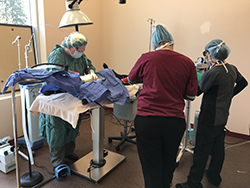Laser Surgery for Regular Surgical Procedures
The surgical laser can be used anywhere a blade can in surgery – but there are several significant differences between a blade-surgery and laser surgery:
- Almost no bleeding – the laser cauterizes blood vessels as it goes
- Less swelling – when tissue is cut, the little fluid vessels called lymphatics are cut too; the fluid oozing out of them is the source of tissue swelling after surgery. The laser seals these off as it cuts.
- Less pain – the laser also cauterizes nerve endings.
 These effects are especially useful for surgery such as the Spay (ovariohysterectomy). The uterus hangs off a “curtain” of thin tissue called the broad ligament, which has its own small blood vessels, lymphatics and nerves. In conventional surgery, this wispy tissue is simply torn, allowing for small vessel bleeding, fluid oozing and raw nerves that contribute to post-op discomfort. In laser surgery, this fine tissue gets separated with the laser, sealing off its cut surface for a more comfortable healing period.
These effects are especially useful for surgery such as the Spay (ovariohysterectomy). The uterus hangs off a “curtain” of thin tissue called the broad ligament, which has its own small blood vessels, lymphatics and nerves. In conventional surgery, this wispy tissue is simply torn, allowing for small vessel bleeding, fluid oozing and raw nerves that contribute to post-op discomfort. In laser surgery, this fine tissue gets separated with the laser, sealing off its cut surface for a more comfortable healing period.

